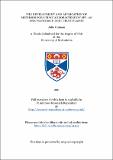The development and application of methods for using 'Agrobacterium' spp. as DNA vectors in soft fruit plants
Abstract
Improvements in soft fruit cultivars have been achieved by the selection of superior genotypes through plant breeding. Limitations imposed by plant breeding, led to work being initiated into the development of a gene vector technique for soft fruit, to permit improvement without altering their overall genetic makeup. Little research has been carried out in this area with perennial crops, cultivars of which are highly heterozygous, their genetic structure being maintained by vegetative propagation. Probably the most successful method of transformation available involves the use of the soil bacterium Agrobacterium. This bacterium is manipulated to contain the gene of interest, and used to infect small explants of the genotype which, can result in gene transfer to some cells of the explant. These transformed cells are induced to regenerate whole plants, which are assessed to select those containing the gene of interest. A transformation system suitable for use in three soft fruit species (Rubus. Ribes and Fraaaria spp.) was developed. Initially these species and Vaccinium spp. were inoculated with a range of wild type Agrobacterium isolates to demonstrate the ability of the isolates to infect. All but one isolate was capable of effecting gene transfer (to some degree) into the plants, which was demonstrated by the production of disease symptoms. Whole plant inoculation was not useful for Agrobacterium transformation, as only the cells at the site of infection contained the foreign DNA. Regeneration techniques were developed for each species, so that the infected cell(s) would regenerate to form whole plants containing the foreign DNA in every cell. With Rubus spp., both leaf disc and internodal segment explants were induced to regenerate whole plants. Generally a larger number of internodal segments than leaf discs regenerated, though the productivity of plantlets from a leaf disc was greater. Cultivars differed in their ability to regenerate. For blackcurrant, an internodal segment system was developed, and for strawberry, leaf disc regeneration was achieved. In Vaccinium spp. regeneration occurred using leaf material. Using these regeneration techniques, transformation experiments were initiated using both the Neomycin phosphotransferase II (NPT II) and the Beta- Glucuronidase (GUS) marker genes. Once putative transformants were selected on kanamycin medium, dot blot, fluorometric, histochemical, and Southern hybridisation assays were carried out. The GUS gene proved especially useful in the identification of transformants, providing a reliable, simple, quick and inexpensive marker gene. The development of transformation systems in soft fruit species has led to experiments being initiated for plant improvement, by the insertion of specific genes, notably genes conferring virus and disease resistance on Rubus and strawberry plants by Agrobacterium.
Type
Thesis, PhD Doctor of Philosophy
Collections
Items in the St Andrews Research Repository are protected by copyright, with all rights reserved, unless otherwise indicated.

